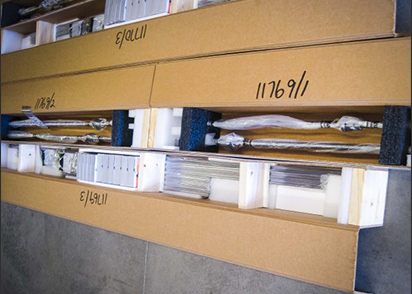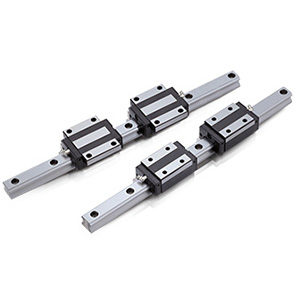
What Are Linear Guides, and Why Are They Critical in Industrial Automation?
Linear guides, also known as linear rail systems, are the foundation of precise, smooth, and controlled motion in automated machinery. Whether you’re building a CNC machine, a packaging line, or a robotic cell, the linear guide system ensures accurate linear positioning under load.
But not all linear guides are built the same. For applications that involve higher loads, longer travel, or increased rigidity, heavy-duty linear guides are a must. Understanding how they differ from standard linear guides is essential to selecting the right system for your machine.
What Makes a Linear Guide “Heavy-Duty”?
Heavy-duty linear guides are engineered for extreme mechanical loads, dynamic forces, and longer duty cycles. While standard linear guides work well in light to moderate applications, heavy-duty versions are specifically designed for:
- High-load industrial machinery
- Large gantry systems
- Material handling and transport applications
- Harsh or high-vibration environments
Key Differences in Construction:
| Feature | Standard Linear Guides | Heavy-Duty Linear Guides |
| Rail Size | Compact, lower profile | Wider, thicker cross-section |
| Bearing Blocks | Smaller contact area | Larger bearing contact surface |
| Load Rating | Light to moderate loads | High static and dynamic load capacity |
| Rigidity | Sufficient for low-stress | Maximized for minimal deflection |
| Service Life | Moderate cycles | Extended lifespan under stress |
Selecting the wrong guide size or load class can lead to premature failure and costly machine downtime.
How Do Load Capacities Compare Between Standard and Heavy-Duty Guides?
The primary performance difference comes down to load handling, both static and dynamic.
Standard Linear Guides:
- Designed for lighter equipment
- Load capacity typically under 10,000 N
- Suitable for lab automation, pick-and-place, or small CNC systems
Heavy-Duty Linear Guides:
- Capable of handling loads well over 50,000 N
- Ideal for multi-axis gantry systems, press automation, and material transport
- Better resistance to moment loads and vibration-induced wear

Load direction also matters. Heavy-duty guides are optimized to handle combined loads (radial, lateral, moment) more effectively, ensuring stability even in off-center or dynamic applications.
What Applications Require Heavy-Duty Linear Guides?
Heavy-duty linear guides are essential in applications where machine reliability, stiffness, and endurance cannot be compromised.
Common Use Cases:
- Industrial CNC routers and milling machines
- Robotics involving payload movement or long reach
- Automated welding or fabrication cells
- Gantry systems in aerospace and automotive assembly
- High-speed packaging or palletizing systems

If your system demands tight tolerances under load or operates in high-cycle or contaminated environments, heavy-duty rails are the reliable choice.
Can Heavy-Duty Linear Guides Be Used in Place of Standard Ones?
Technically, yes, but it’s not always practical. Heavy-duty guides provide more performance, but they also come with:
More rigid mounting requirements
Larger physical footprint
Higher cost
Standard linear guides are often a better choice when space is limited, loads are predictable, and cost efficiency is key.
The right guide system is the one that meets your performance goals without overengineering.
How Accu Tech USA Supports Your Linear Motion Needs
At Accu Tech USA, we provide a wide range of linear guide systems designed for both standard and heavy-duty applications. Our engineering team helps machine builders and automation designers:
- Select the right rail size, preload, and material
- Match guide systems to expected life cycles and duty requirements
- Ensure smooth installation with precision-ground components
- Integrate linear motion into complete gantry or automation platforms
Whether you’re replacing a worn guide or designing a new motion system, we’ll help you select the optimal solution with performance and longevity in mind.
Not Sure Which Guide Is Right for Your Application?
If you’re facing any of the following, it’s time to evaluate your linear guide selection:
- Inconsistent machine performance under load
- Wear marks or scoring on rails
- Premature bearing failure or rail deflection
- Need for longer travel lengths or increased stiffness
Accu Tech USA can help you assess your current motion system and recommend the right standard or heavy-duty rail solution for your operation.
Talk to a Linear Motion Expert Today
Selecting the wrong guide system can cost more in maintenance, downtime, and lost precision. Let us help you find the right linear guide for your environment, load requirements, and budget. Contact Accu Tech USA to speak with a linear motion specialist.

FAQ: Heavy-Duty vs. Standard Linear Guides
What is the difference between standard and heavy-duty linear guides?
Standard linear guides are designed for moderate loads and precision in compact applications. Heavy-duty linear guides, by contrast, have thicker rails, larger bearing surfaces, and higher load capacities and are ideal for demanding environments like CNC machines, gantries, and material handling systems.
When should I use a heavy-duty linear guide instead of a standard one?
Use heavy-duty linear guides when your application involves high loads, long travel distances, high duty cycles, or harsh environments where rigidity, durability, and vibration resistance are critical.
Are heavy-duty linear guides more accurate than standard guides?
Heavy-duty guides are not inherently more accurate, but their increased rigidity and load capacity help maintain consistent accuracy under stress. This makes them better suited for precision tasks in high-load or dynamic environments.
Can I replace a standard linear guide with a heavy-duty one?
Yes, but it’s important to ensure the mounting footprint, load specs, and machine design support the change. Heavy-duty guides are physically larger and may require structural modifications for proper integration.
How do I choose between heavy-duty and standard linear guides?
Start by evaluating your application’s load requirements, duty cycle, environmental conditions, and space constraints. If you’re unsure, Accu Tech USA can provide expert guidance based on performance, longevity, and cost-effectiveness.
